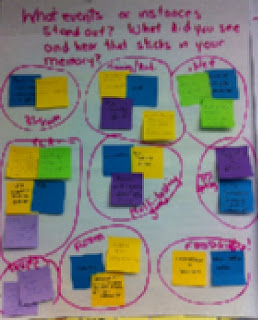Monday, March 9, 2015
Silent Brainstorming
"Cognitive fixation causes people to focus on other peoples ideas and are, inevitably, unable to come up with their own."
"If the goal is to come up with a bunch of unique ideas or solutions to problems, then the group should be split up so that individuals can come up with their own ideas and these ideas can later be combined with other members ideas."
"...a group session after an individual session might be the optimal brainstorming technique."So how can you combine both individual and group brainstorming? Here is an approach that I have been using that Ive put together based on my experiences facilitating and participating in other sessions. This approach can be used for any brainstorming session whether you are trying to generate user stories, ideas for a retrospective, or strategies for your community group.
Step 1: Establish the goal.
Make sure everyone understands the purpose of the brainstorming session. For many sessions this can be communicated to attendees before the meeting begins.
Note: If your group is larger than 10, I would recommend splitting the group up into several smaller groups for steps 2 through 5. The groups can present their best ideas to each other at the end of the exercise and re-open the discussion and voting at that point if appropriate.
Step 2. Individual (and silent) brainstorming.

Step 3. Describe your ideas
Once everyone has finished writing down their ideas, choose one person and ask them to describe their best idea and then place that post-it on the wall or the table. Continue going around the table asking each person to describe their top one idea until all ideas have been presented. It should take several rounds and each person will have the opportunity to present several ideas - one during each round. While the ideas are being described encourage everyone to keep writing additional ideas down. This allows the group to combine and improve upon ideas presented by others.
Step 4. Group the ideas
 There are several ways to group the ideas depending on your group size.
There are several ways to group the ideas depending on your group size.a) If your group size is five or less I prefer using silent affinity grouping because it is fast and collaborative. Ask your team to silently group the ideas. Things that are similar to each other should be moved closer to each other. Things that are dissimilar to each other should be moved farther apart. Groups should form naturally and fairly easily. Once again, body language will help you see when they are done - usually 2-3 minutes.
b) If your group size is more than five I prefer to have one person group the post-its as they are presented because it is faster. Simply put the post-it near other post-its with similar ideas.
Once the groups are created you can name each group with a short title.
Step 5. Silent Voting
If you need to vote on the ideas or on the groups, I prefer using silent voting. Number each post-it and then ask each person to write down their top three on a post-it. Once all the votes are in, tabulate the votes to identify the top ideas.
Summary
This method of brainstorming combines the best of both individual and group brainstorming techniques and is consistent with the latest research. However, I initially started using it not because it conforms to the latest research but because it allows everyone to have a voice - the loud people cant dominate the conversation and the quiet people are given a way to contribute. That it reduces the effect of cognitive fixation when generating the initial list of ideas is an added benefit.
References:
- http://www.businessinsider.com/brainstorming-team-building-effectiveness-2012-1
- http://onlinelibrary.wiley.com/doi/10.1002/acp.1699/pdf
- I was videoed by InfoQ talking about Silent Brainstorming at SDEC12. Watch the video here.
Labels:
brainstorming,
silent